12 adventures in Yosemite National Park for families with kids
- Blog 12 adventures in Yosemite National Park for families with kids
Yosemite is an 1,169-square-mile national park in the Sierra Nevada mountains of California. It was first protected by President Lincoln in 1864 before becoming a national park since 1890. It contains an amazing collection of natural wonders, including world-class waterfalls, huge granite features, stunning mountain lakes, giant sequoia trees, famous viewpoints and miles upon miles of trails. Yosemite gets about 4 million visitors a year. And unfortunately, there are also about 15 fatalities a year, most commonly due to drowning, falling and vehicular accidents. This is a wild place, so please use caution and common sense. 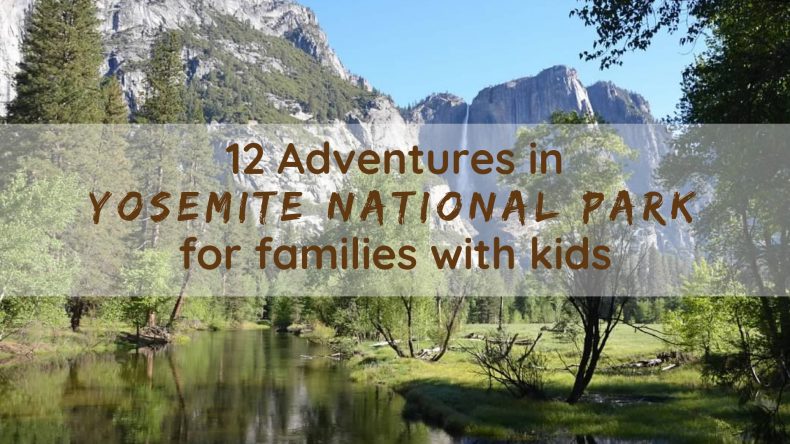
Planning
Seasons
Because Yosemite is in the Sierra, the time of year you visit has a big impact on where you can go and what you can do. In the winter, Tioga Road, which crosses Yosemite east to west, is buried in snow and closed, so there is no access to Tuolumne Meadows. Likewise, Glacier Point Road is closed. Because of this, in the winter, you may be required to carry or install tire chains. It could be sunny and beautiful one day and snowing the next.
In addition, the Mariposa shuttle does not run in the winter, and most (but not all) of the campgrounds are closed. In winter, it’s also much less crowded. Spring can bring campground or service closures due to flooding or winter storm damage. Summer is fire season, which can close roads or fill the Valley with smoke.
Geography
On the west side, Yosemite has three entrances. From north to south, they are Hwy 140, Hwy 120 and Hwy 41. Hwy 140 (El Portal entrance) is the lowest elevation and the one that leads right into the Valley. Hwy 120 (Big Oak Flat entrance) goes by the Tuolumne and Merced sequoia groves. This road becomes Tioga Road, or you can take a branch down into the Valley at Crane Flat where there is also a gas station. Hwy 41 (Wawona entrance) goes by the Mariposa sequoia groves and the Glacier Point Road spur before heading down into the Valley. On the east side, Tioga Pass (Hwy 120) is the only entrance, and it is at a high elevation (9,943 feet). From there, the road goes through Tuolumne Meadows, past Tenaya Lake and Olmstead Point, and then to Crane Flat where you can go down to the Valley or continue west toward the coast.
Lodging
There are many options for lodging and the closer you are to the high season, the further ahead you must make reservations. Camping reservations for the campgrounds in Yosemite (especially in the Valley) are taken within hours (or even minutes) of them coming available. There are walk-in sites, but lines can be long and form early. Besides regular tent and RV campgrounds, there are tent cabins (some heated!) and various lodges within the park.
The Awhwahnee Hotel (currently renamed to the Majestic Yosemite Hotel) is the cream of the crop and the price reflects that. Outside the park you have many choices. When we’re visiting the Valley, we usually stay at one of the hotels in El Portal, just outside the Hwy 140 entrance. If those are booked or too expensive, the town of Mariposa is our fallback. We did once stay in one of the heated tents in Half Dome Village in January, and that was a fun experience (but those tents are usually more expensive than a hotel room in El Portal). On the east side, I’ve stayed in Lee Vining.
In the summer, we try to camp but have also stayed at rental homes in and around Groveland for group events. If you’re visiting Yosemite as a once-in-a-lifetime trip, I would recommend staying in the park if you can. It will save time, make access to the shuttle easy and make it easier to do morning and nighttime activities, including some ranger-led opportunities (morning coffee with a ranger, nighttime campfires, stargazing walks, moonlight walks and night photography).
Food
Groceries are available at Yosemite Village (in the Valley) and Tuolumne Meadows. There are restaurants in Yosemite Village, Half Dome Village (previously known as Camp Curry) and at the Majestic. Most appealing to kids might be the pizza at Half Dome Village, but the wait can be long if the park is crowded. Further out, there is a grill in Tuolumne Meadows, restaurants in Wawona/Fish Camp, and some of the hotels in El Portal have restaurants. Yosemite has a lot of wildlife that will take advantage of available food. Make sure to follow the restrictions for keeping animals (bears included) out of your food, such as removing all food from your car.
Packing
In the shoulder seasons, the weather can change quickly – even the Valley floor is at 4,000 feet – so pack hats, sunscreen and lip balm all year round. Also, the mountains will dry you out quickly, so bring things to carry water around with you. And depending on the season (and when this is will vary year to year depending on the snowfall), the mosquitoes can be hungry, so don’t forget your favorite repellant. (Don’t worry about bringing bear spray; it’s not allowed in the park.)
12 Fun things to do with kids in Yosemite
1. Viewpoints
For an easy-to-get-to viewpoint, stop at Tunnel View. This is a short drive up Wawona Road from where it climbs out of the Valley near Bridalveil Falls. You get a view of the Valley framed by El Capitan on the left and Bridalveil Falls on the right. In the distance, you can see Half Dome, which makes a great backdrop for a family photo. There’s a bronze map of the Valley you can use to see where you’re going or where you’ve been. Another classic view is Glacier Point. It has an edge-on view of Half Dome and an overhead view of Vernal and Nevada Falls, plus you can look down into the main part of the Valley. My other favorite drive-up view is Olmstead Point. You can see Cloud’s Rest and Half Dome in the distance and it’s an easy place to experience the bare granite. 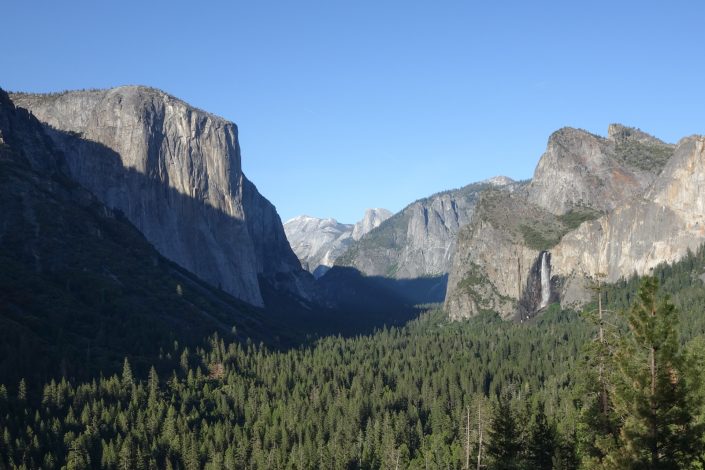 Tunnel View
Tunnel View
2. Playing at a Merced River Beach
The Merced River winds its way through the Valley. In the warmer months, wading in the river is a lot of fun. Otherwise, throwing stones into the river has been a favorite pastime for our son for years. Cathedral Beach has a stunning view of El Capitan and if you walk a bit upriver, the Three Brothers. Sentinel Beach has a good view of Yosemite Falls as does Swinging Bridge. The beach behind the main Village parking area has a good view of Half Dome. In the spring, the water is higher, faster, colder and dangerous, so exercise caution! In the late summer or fall, you can sometimes step across the river without getting your feet wet. 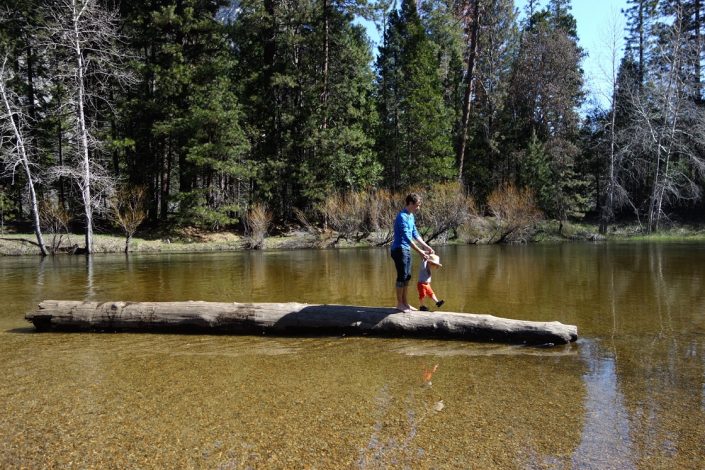 Merced River beach
Merced River beach
3. Easy waterfall hikes
The hikes to the base of Bridalveil and Yosemite Falls are both short and fully paved. Bridalveil is a bit more than a mile, and Yosemite is about a half mile. Both also have other approaches if you want a more leisurely or scenic route. In the spring or early summer, these are exciting falls and the final approach will be cold, wet and slippery. In the fall and winter, they can be entirely dry. But there are other waterfalls in the park you can explore that vary in distance. 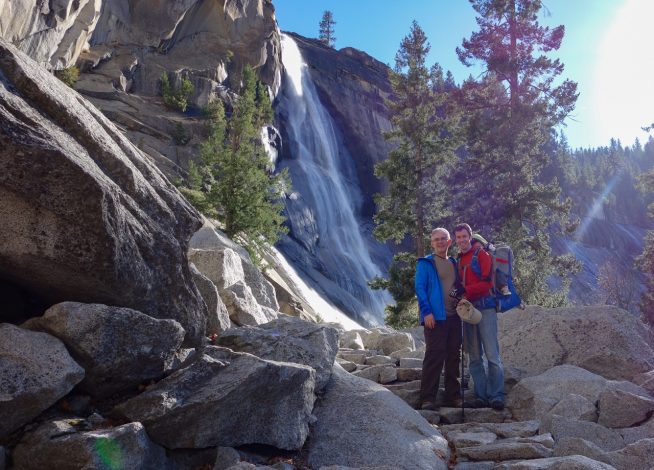 Nevada Falls
Nevada Falls
4. Mirror Lake hike
This is an easy, fairly flat hike in the Valley that is 2 miles roundtrip, but with possibilities for extensions. You can get to it from shuttle stop #17, the North Pines campground or the Majestic hotel. The trail is paved up to the lake, and pets and bicycles are allowed up to the end of the pavement. There is also a restroom (but no water) here. It is possible to get vehicle access to this point if you have a disabled placard, but the parking is very limited. In the high summer and fall, Mirror Lake can be a lot smaller. For a longer hike, you can continue past Mirror Lake for another 1.2 miles and then return on the other side. If you came via shuttle stop #17, you can take a short connector and return via a different, wilder trail to the Majestic hotel (shuttle stop #3). 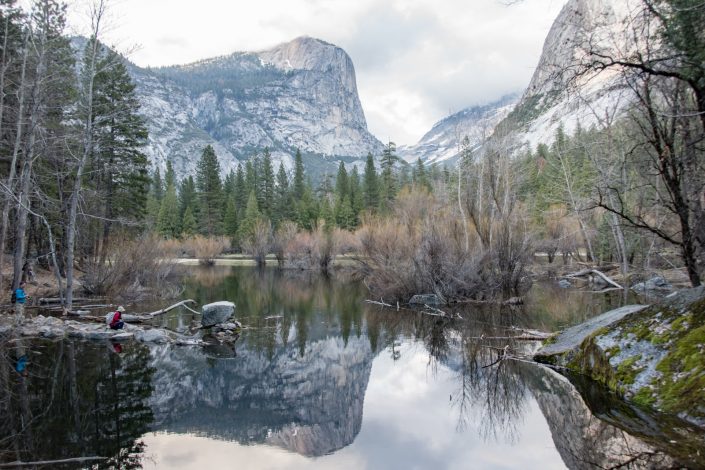 Mirror Lake
Mirror Lake
5. Sentinel Dome hike
This is a slightly more difficult hike except for the last bit, which is a short, steep climb. It is 2.2 miles roundtrip from Glacier Point Road. The top of Sentinel Dome gives amazing views across the Valley to Yosemite Falls and up the valley to Half Dome and the various peaks behind. On a clear day, you can supposedly see all the way to Mt. Diablo in the San Francisco East Bay. The top can be quite windy and colder than the hike, so be prepared for that. Also, there are steep, deadly drops, so keep the kids close if you decide to do this hike. Along the way, try sniffing the cracks between the bark of some of the larger pine trees. Some of them smell like butterscotch! From here, you can hike to Glacier Point, or you can take a semi-loop to Taft Point and then back to the trailhead. Taft has an amazing view of El Capitan, especially at the end of the day. 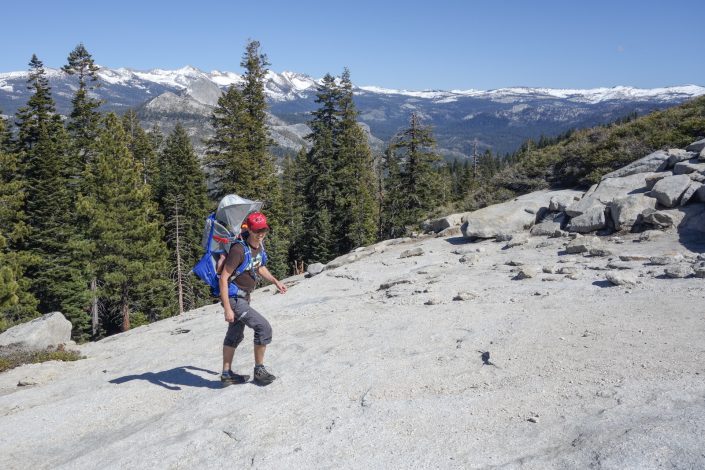 Sentinel Dome
Sentinel Dome
6. Tenaya Lake
Tenaya Lake is a truly beautiful lake just to stop at and admire the scenery. There are multiple parking areas right along the road to Tuolumne Meadows. In the summer, you can swim or wade. It sits at 8,200 feet, so this is a great option for the height of summer. The elevation also means you can get a sunburn very quickly. The northeast end has a huge sandy beach; the middle has a great viewpoint and some places with sand and others with shallow granite slabs; and the southwest end has a smaller sandy beach and great views of the granite at the opposite end of the lake. Anywhere at Tenaya Lake is a great place for a picnic lunch. 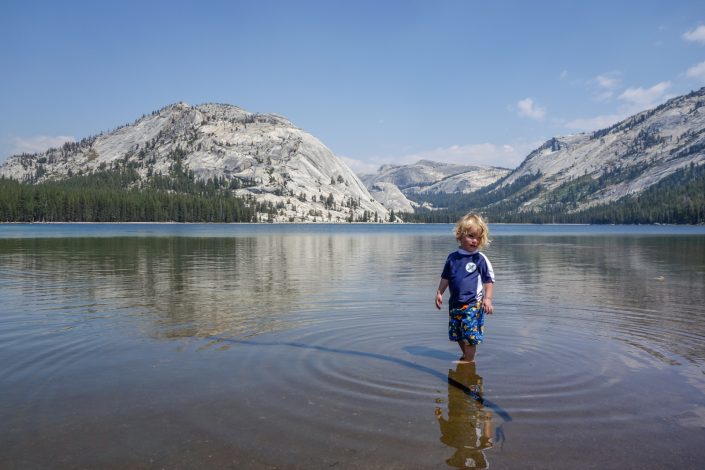 Taneya Lake
Taneya Lake
7. Domes in Tuolumne Meadows (Pothole or Lembert)
For a stunning view of Tuolumne, climb one of the domes. Lembert Dome just off Tioga Road is a classic, but at 3 miles and 900 feet of elevation gain, it can be a lot, especially if the elevation (8,500 feet) is getting to you. Pothole Dome at the western end of the meadow is lesser known and an easier hike – less than 1/3 the distance and 1/3 the elevation – but it still has a great view. As with Sentinel Dome, there are sheer drops here so watch your kiddos if needed. 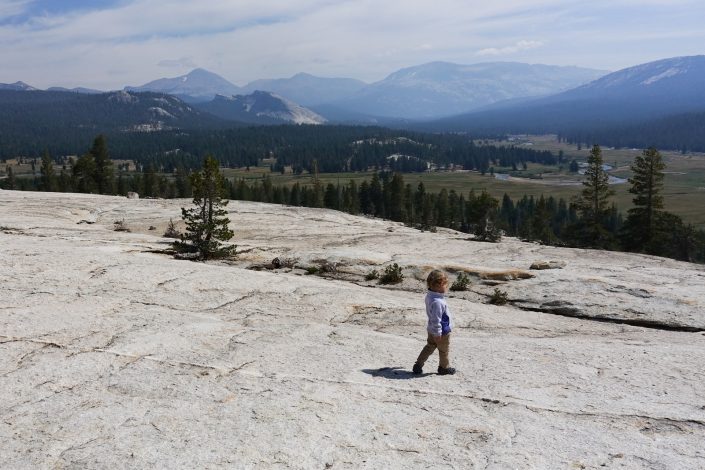 Pothole Dome
Pothole Dome
8. Vernal and Nevada Falls hike
This is one of the all-time classic hikes of Yosemite, though not an easy one. We’ve done it twice with a kid, once carried and once on his own feet. It is accessible from shuttle stop #16 (Happy Isles). There’s also a parking area between Happy Isles and Half Dome Village, but the shuttle will save you some hiking. The trail to the top of Vernal Fall is about 3 miles roundtrip and 1,000 feet of gain. To the top of Nevada Falls is about 7 miles roundtrip and 2,000 feet of gain (if you do both routes). The beginning of the trail is a long, slow grind upward. You quickly get well above the river and have interesting views over the wall to it. After the footbridge with the view of Vernal Falls, you have a choice between the Mist Trail with its big steps or the John Muir Trail. Mist Trail is shorter and steeper, more crowded and has a closeup view of the falls.
If the water is flowing hard, the trail will be covered in mist, the steps will be slippery and you’ll get wet. The John Muir Trail is calmer, but a lot of extra effort if you’re going to Vernal and not Nevada Falls. Tip: Going up the steps is easier than coming down, especially if it’s getting dark, so I prefer to go up the Mist Trail, continue to Nevada Falls and come down the John Muir trail. I usually take a break at Emerald Pool just above Vernal Falls and at the area just above Nevada Falls. Beyond Nevada, the trail continues to Little Yosemite Valley, Half Dome (if you’re climbing Half Dome, this is just the beginning) and wilder areas of Yosemite. 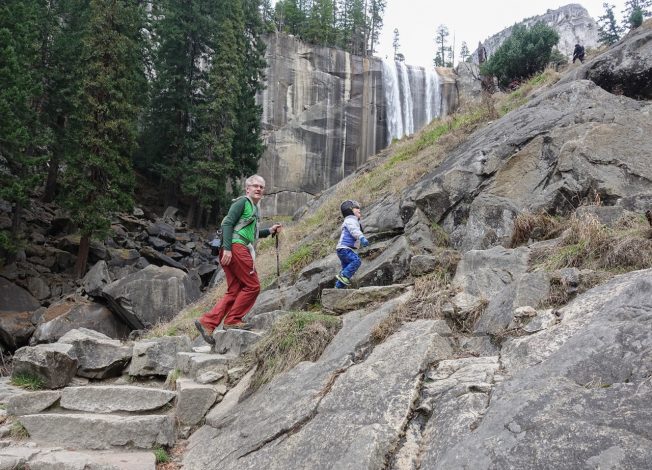 Vernal Falls
Vernal Falls
9. Visit a Sequoia Grove
Yosemite has three sequoia groves. Tuolumne and Merced Grove are in the north; Tuolumne is just east of Crane Flat and Merced Grove is about 6 miles west of Crane Flat. Both are smaller with about two dozen mature trees and involve a 1- to 1.5-mile hike downhill to get to the trees. Mariposa Grove in the south is much larger and more spread out and has a variety of trails – some flat and easy and some hilly. Most of the year you have to take a shuttle from the parking area to the grove trailhead. Mariposa Grove has the famous trees like Grizzly Giant, Fallen Monarch, California Tunnel Tree, Three Graces and Wawona Tunnel Tree (fallen). The Grizzly Giant Loop is 2 easy miles. The Big Trees Loop is less than a half mile and is wheelchair-accessible. 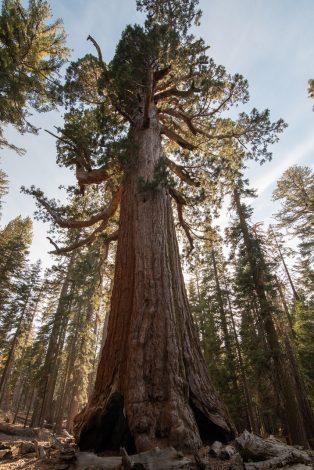 Mariposa Grove
Mariposa Grove
10. Miwok experiences and Yosemite Village
The Yosemite Museum (the first national park museum) area has some interesting exhibits. Just outside the entrance to the building is a Miwok-style bark hut and a sequoia tree slice. Inside the museum are some artifact exhibits, including some very impressive baskets. A separate room holds temporary exhibits with amazing art. For kids, there are some touchable exhibits and there is usually a person doing a kind of Show and Tell with demonstration.
Behind the museum is a partial recreation of a Miwok village with a variety of sample structures. Next to the museum is the Visitor Center which has a large 3D map of Central Yosemite along with a bookstore and gift shop. This is the place to stamp your NPS passport and pick up or turn in the Junior Ranger booklet. Next to the Visitor Center is the Ansel Adams Gallery where you can buy prints or reproductions from Ansel Adams and other artists. And beyond that is a deli, grocery store and grill. 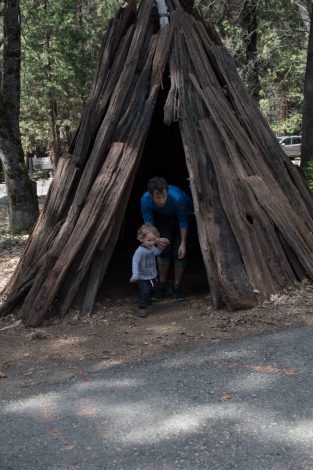 Miwok hut
Miwok hut
11. Programmed activities
There are a variety of programmed activities that you can do year-round. Some are free and some cost extra. When you enter the park, you’ll be given a newspaper-style Yosemite Guide handout with the seasonal schedule. Activities run all day and even into the night. If you’re staying at a campground, there might be a campfire with stories or music. There are sunrise walks for early risers and evening astronomy talks for night owls. There are professional photography tours, guided hikes, art classes, live storytellers, video documentary showings with discussions, and ranger walks for kids and adults. The Junior Ranger program, recommended for ages 7-13, starts at the Visitor Center and includes a Yosemite specific activity booklet. There’s also a simpler program for younger kids. Visit the National Park Service website for a preview of the activities. 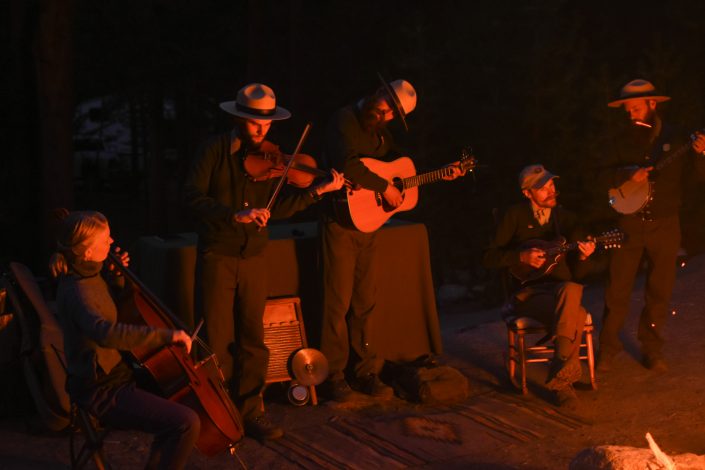 Campfire
Campfire
12. Hetch Hetchy
If you’re visiting Yosemite in the off-season and want to see more than the Valley, or you want to escape the Valley crowds, Hetch Hetchy is the place. Originally a valley like Yosemite, it was dammed and is now a reservoir for San Francisco. However, it still has big granite cliffs, spring wildflowers, waterfalls and excellent hiking with a very long hiking season (although it can be quite hot in the summer). Shorter hikes to consider are Lookout Point (2 miles roundtrip) and the base of the 1,400-foot Wapama Falls (5 miles roundtrip). If you’re looking for more adventures, some additional ideas places we’ve explored are Cathedral Lakes, North Dome, Glen Aulin, Elizabeth Lake, May Lake, Gaylor Lakes and Dewey Point. 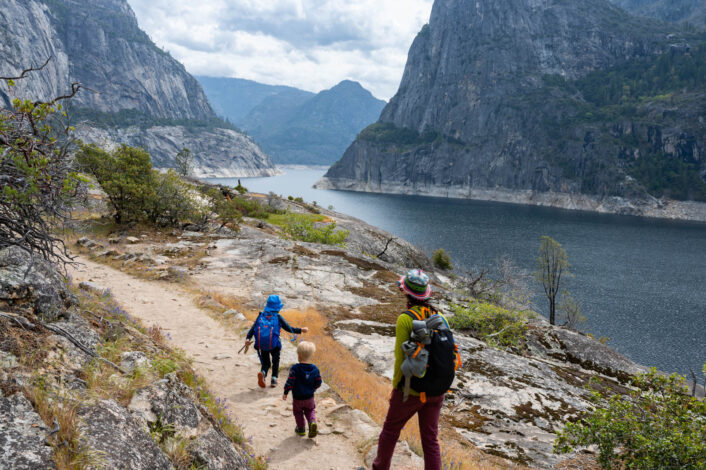 Have you visited Yosemite National Park? If so, what are some of your favorite family-friendly outdoor adventures in the area? Let us know in the comments below!
Have you visited Yosemite National Park? If so, what are some of your favorite family-friendly outdoor adventures in the area? Let us know in the comments below!
Read more:
- 10 Fun things to do with kids in Yellowstone
- 10 Unforgettable things to do in Glacier National Park with kids
- 10 Places to visit in Acadia National Park with kids
Photos provided by Ryan Idryo. Feature photo by Vong Hamilton.
ABOUT OUTGROWN
OutGrown is a 501(c)(3) nonprofit that works to create a world where everyone can enjoy the physical and mental benefits of spending time outside. We are focused on creating opportunities and removing barriers to access so families with babies and young children can take their first steps outside. We believe all families have the right to connect with nature, benefit from spending time outdoors and be inspired to a lifelong love of nature. Since its grassroots inception in 2013, OutGrown is a growing community of 280,000 families and over 300 volunteer Branch Ambassadors. More information on all of our programs can be found at WeAreOutGrown.org
EDITORS NOTE:
We hope you enjoyed reading this article from OutGrown. We’re working hard to provide our community with content and resources that inform, inspire, and entertain you.
But content is not free. It’s built on the hard work and dedication of writers, editors, and volunteers. We make an investment in developing premium content to make it easier for families with young children to connect with nature and each other. We do not ask this lightly, but if you can, please make a contribution and help us extend our reach.
Related Content





Comments